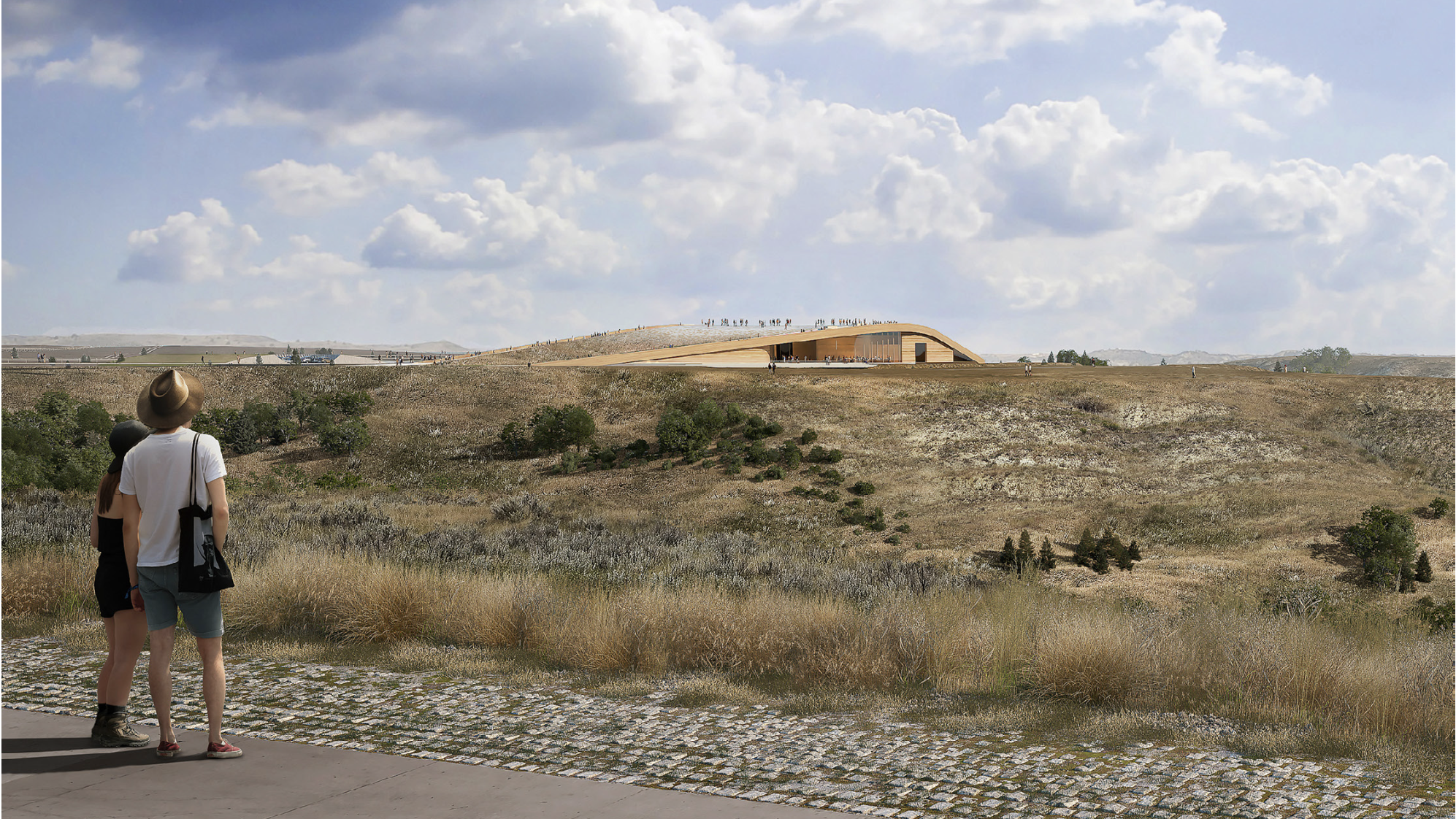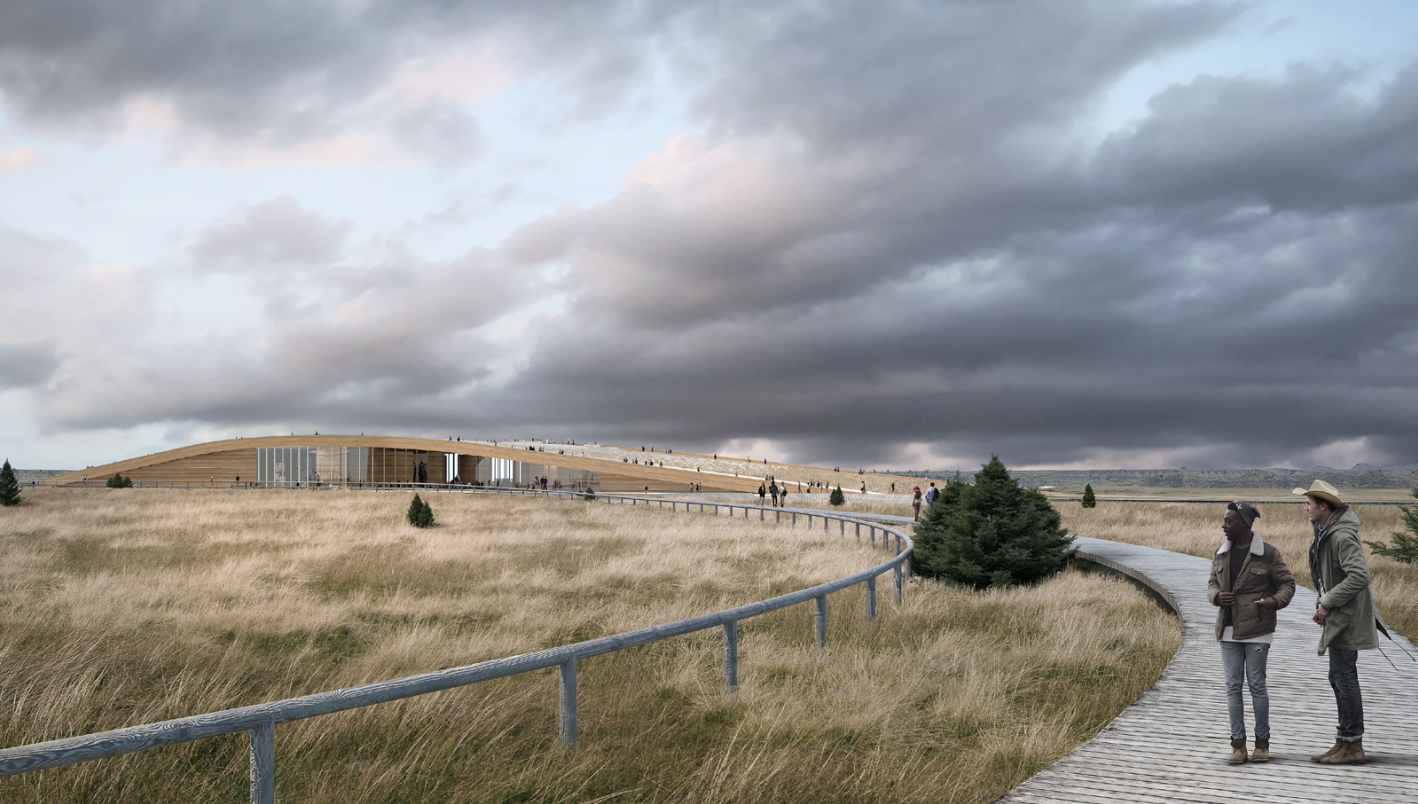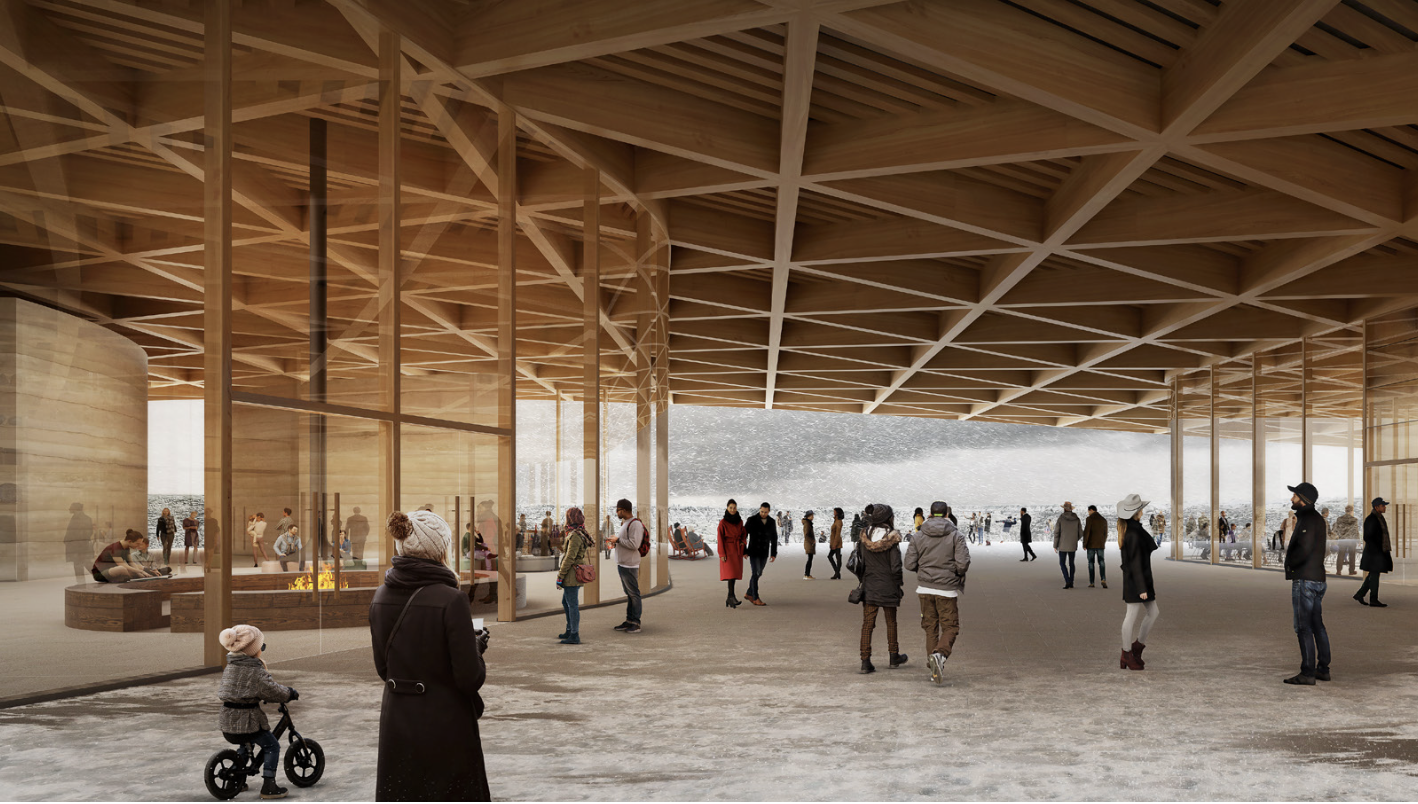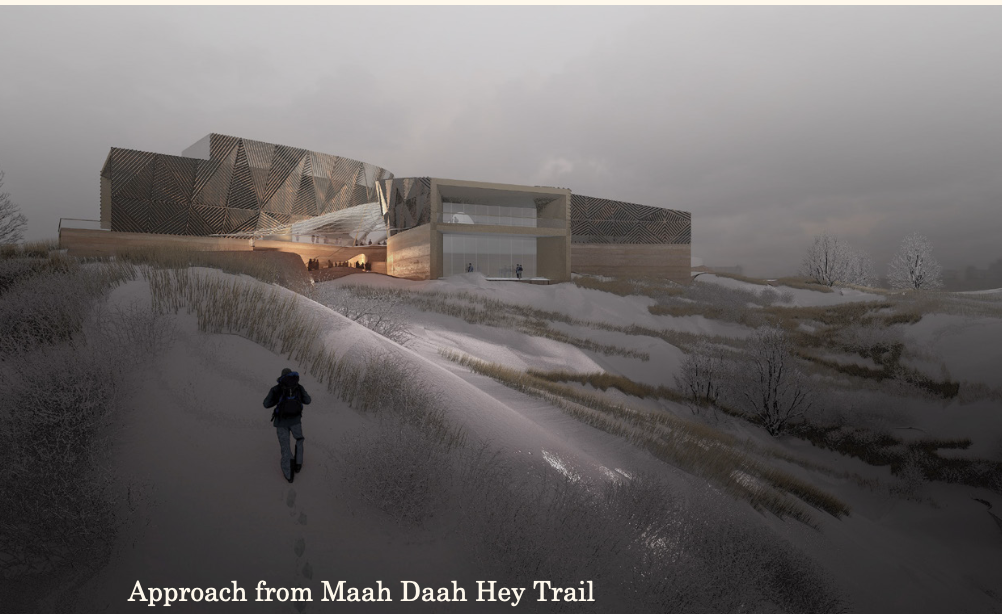Architectural Design Concepts Unveiled
Henning Larsen Presents Design for Theodore Roosevelt Presidential Library
Our design is inspired by the rich landscapes of the North Dakotan Badlands, united by Theodore Roosevelt’s legacy, and rooted in the community of Medora.
17 August 2020
In a single, dark February day in 1884, Theodore Roosevelt’s mother and wife passed within hours of each other – an event he com- memorated in his diary: “The light has gone out of my life.” Deep in grief, he journeyed from New York City to Medora, North Dakota, where his time in the Badlands would come to transform and define him as the man, conservationist, and American civic icon we remember today.
The Henning Larsen + Nelson Byrd Woltz design team made the same journey across the United States in early June 2020 to visit the site for the Theodore Roosevelt Presidential Library. Our vision for the project is rooted in the landscape and community that Roos- evelt came to love – a landscape and community as rich and resilient today as it was when Roosevelt lived in it nearly 150 years ago.
“There is a unique and awe-inspiring beauty to everything about the Badlands that you simply cannot experience anywhere else,” says Michael Sørensen, design lead and Partner at Henning Larsen. “The landscape only fully unfolds once you are already within it; once you are, the hills, buttes, fields, and streams stretch as far as you can see.”
Our vision is deeply tied to this landscape. Thomas Woltz, Principal and founder of Nelson Byrd Woltz remarks, “The design fuses the landscape and building into one living system emerging from the site’s geology. The buildings frame powerful landscape views to the surrounding buttes and the visitor experience is seamlessly connected to the rivers, trails, and grazing lands surrounding the Library.” The building is comprised of four volumes that peek up from the butte, each a formal reference to the geography of the Badlands. With the tower (the Legacy Beacon) a visible landmark, the library becomes a hub for community and fluid threshold over which visitors can cross into the sprawling majesty of the Theodore Roosevelt National Park. The four volumes link underground along a continuous narrative trail where Roosevelt’s legacy – the roots of the project – is exhibited and experienced.
From the lobby, visitors follow a sloping spiral path down to the exhibition level, where they encounter seats that encircle a hearth. It is here that the journey begins, gathered together around the fire as Roosevelt himself would have done. The path, entitled The Hero’s Journey, is not just an exhibition of his life, work, and legacy, but is also a showcase for the landscape. Each phase of the exhibition is punctuated by a space that overlooks a different aspect of the surroundings, showing off the changing nature of the Badlands from every vista and vantage. Where the exhibition spaces at the start are dark, lit by soft daylight that streams in from above, the final stop bathes them in full daylight as they are presented with a panoramic view onto the Library and landscape from the Legacy Beacon (whose form echoes the iconic markers on the Maah Daah Hey trail).
“Theodore Roosevelt famously stated ‘I never would have been President if it had not been for my experiences in North Dakota.’ After just the small amount of time we’ve been able to spend in Medora, it’s clear to us what he meant. The landscape, the people – and the spirit they are both imbued with – is unique, rich, and indomitable,” says Sørensen. “We’re honoured to be a part of Medora’s story and hope to help realize this part of its future.”
Henning Larsen is an internationally recognized architecture studio whose goal is to create vibrant, sustainable buildings that reach beyond themselves and provide durable value to the users, the society, culture, and landscapes they reside in. Nelson Byrd Woltz Landscape Architects is an internationally recognized design practice whose research-based process generates designs that are an- chored in the cultures and ecologies that shape landscapes. The team is completed by Sherwood Engineers and Integral Group.
Snøhetta’s design for the Theodore Roosevelt Presidential Library is a journey through the North Dakota Badlands.
Snøhetta’s design for the Theodore Roosevelt Presidential Library is informed by the President’s personal reflections on the landscape, his interest in environmental stewardship, and periods of quiet introspection and civic engagement. The design of the Library is more than a building, it is a journey preserving the existing landscape of diverse habitats punctuated with small pavilions allowing for reflection and activity. Its gently sloping roof looks to the northeast, gazing out to the National Park, historical settings in the Little Missouri River valley, and the Elkhorn Ranch far in the distance, further connecting the Library of tomorrow with its origins from the past.
The main building for the Presidential Library is defined by its unique roof rising from the butte, echoing the landforms of
the surrounding Badlands. Visitors can ascend the accessible rooftop to discover commanding views of the National Park and Medora during the day, as well as an ideal location for stargaz- ing at night. Inside the Library, large windows highlight views to historically significant landscapes and complement the rhythm of the interactive exhibitions within. A generous covered porch overlooks the nearby valleys and can be used for gatherings throughout the year.
The Library’s location at the northeast edge of the butte pre- serves the landscape for research while offering a setting for educational walks, leisure, and recreation. As visitors set out on a loop from the Library, they will encounter adventurous paths which connect to the nearby Maah Daah Hey Trail as well as several small pavilions. Ranging from contemplative nooks to expansive vistas, these pavilions allow visitors to experience Roosevelt’s trials and triumphs in in dialogue with the land- scapes that shaped him. Pavilions may also be used at other important locations related to the National Parks or include a facsimile of T.R.’s early Elkhorn Ranch cabin.
The Library also functions in harmony with the unique ecology of the region and expresses the conservation ethos for which Roosevelt is remembered. Its construction will use natural and renewable materials, while its sophisticated energy systems will set a new standard for sustainable design in the region. Our design is oriented to diminish the impact of wind and other climatic factors so that the Library will be accessible in all seasons.
Facing northeast, the new Library looks onto the Little Missouri River, the former military camp called the Cantonment, and
the original train depot in where T.R. first arrived in the area.
A parking option at Pacific Avenue nearby these locations, which we call the Depot, will allow visitors to connect easily
to the town, the National Park, and the Library. A caravan from the Depot will bring visitors on a dramatic electric train ride through a nearby wash to the Library atop the butte. This elec- tric caravan can be expanded over time to support an ecosys- tem of destinations in Medora and the National Park.
Snøhetta’s design for the Theodore Roosevelt Presidential Library strengthens connections to the town of Medora. Through strategies that streamline and activate the visitor experience, we see opportunities to connect the project to larger institutions such as the National Park Service, universi- ties and schools, and look forward to engaging in a participatory design process to bring community input into
a realizable project. Drawing a continuum between past and present, our design captures the legacy of T.R., while also inspiring a commitment to the longevity and health of the region. We see this design process as more than just creating a building; it is about making a place for community, rooted in T.R.’s story and composed of all those who call North Dakota home.
Studio Gang and OLIN’s Designs for the Theodore Roosevelt Presidential Library
Studio Gang and OLIN’s Theodore Roosevelt Presidential Library is conceived as a basecamp embedded in the North Dakota Badlands—a transformative gathering place where immersion in T.R.’s story and the surrounding environment brings people together to find common ground and inspires and equips them to launch back into the world with renewed passion and purpose.
“Our design is inspired by T.R.’s dual love of learning and the outdoors.
As the first Presidential Library attached to a National Park, the project is poised to foster greater understanding, environmental stewardship, and healing in one of North America’s most incredible natural places. Intimately connected with the ecology of the North Dakota Badlands, Basecamp will at once draw people inward for intellectual exchange and direct them outward for physical exploration, allowing them to discover new connections with each other and the natural world.”
—Jeanne Gang, Studio Gang Founding Principal
Like one of the Badlands’ fantastic rock formations, the building emerges from the land as if carved away by water and wind. The building is composed of three, horseshoe-shaped elements that organize the different functions of the Library. Each horseshoe houses the distinct activities on the inside while simultaneously embracing the dramatic outdoor environment, creating protected gardens and terraces that offer varied views of the landscape, showcase native plant communities, and provide habitat for wildlife.
The spaces between the volumes act like the cracks in the Badlands’ clay-rich soil, allowing light and air to enter the interior. At the building’s heart, the three horseshoes tilt upward to form a grand, dome-like central space from which all of the activities of the Library can be seen and explored.
Importantly, the design treats architecture and landscape as symbiotic and intimately connected with the site’s greater ecology. Informed by nature’s means of resilience in the harsh conditions of the Badlands, the project’s passive and active green strategies work together to achieve a net-zero, carbon-neutral Library with a healthy, inspiring environment full of natural light and fresh air. In addition, the design integrates an ecological restoration and management plan for the entire site that will heal and renew the surrounding ecosystems over time, making the Library a living model for how people, wildlife, and agriculture can coexist and thrive.
About Studio Gang:
Studio Gang is an international architecture and urban design practice founded and led by Jeanne Gang. Driven by an ethos of actionable idealism, the Studio uses a research-based design process to create places that build stronger relationships among people, communities, and the environment. The Studio’s award-winning work includes the Arcus Center for Social Justice Leadership at Kalamazoo College (2014) and the Nature Boardwalk and Pavilion at Lincoln Park Zoo (2010). Upcoming projects include Richard Gilder Center for Science, Education, and Innovation at the American Museum of Natural History in New York City, Tom Lee Park in Memphis, and the Global Terminal at O’Hare International Airport in Chicago (also with OLIN). Named Fast Company’s #1 Most Innovative Architecture Company and the subject of a recent Phaidon monograph, Studio Gang is headquartered in Chicago with offices
in New York, San Francisco, and Paris. For the Theodore Roosevelt Presidential Library project, Studio Gang is collaborating with OLIN as well as Applied Ecological Services, Atelier Ten, Guy Nordenson & Associates, and Arup.












